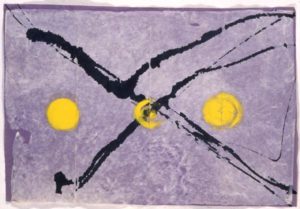
Inner Space by Luciano Bartolini
by Nina
In the brief moment between when you experience a strong emotion and then react to it, you have the opportunity to pause briefly to study what you’re experiencing. For both yoga practitioners and for Buddhists, this moment is considered so important for responding skillfully to thoughts and emotions that it is called a “sacred “or “precious” pause. Jack Kornfield describes it this way:
“In a moment of stopping, we break the spell between past result and automatic reaction. When we pause, we can notice the actual experience, the pain or pleasure, fear or excitement. In the stillness before our habits arise, we become free.”
To take the precious pause, step back and observe what you’re feeling—along with any associated physical symptoms—without reacting to them. Use your witness mind, the part of your mind that allows you to impartially observe thoughts, emotions, and sensations. Simply focus intentionally both on what you’re feeling—physically and emotionally—and on what you’re thinking. Tune in to your body to observe the type of energy and the physical sensations you’re experiencing. Allow yourself to fully experience your emotions and observe the thoughts those emotions trigger.
During this process, try to employ radical honesty, observing what you feel and think without shame or any kind of judgment. In the Yoga Yajnavalkya, Hatha Yoga Pradipika, and other yoga texts, one of the ten yamas is arjava (honesty), which means being truthful with yourself, as opposed to satya (truthfulness), which means speaking the truth with others. Practicing this type of honesty can be a good way to really get to the bottom of things.
Taking this precious pause when you feel anger, fear, or anxiety surging may reduce the intensity of the emotion itself. At this time, you also have the opportunity to listen for signals the emotion might be sending you. Perhaps you or someone else are in actual danger and should respond by taking protective or evasive actions. Having lived through a serious earthquake, I feel a surge of fear every time my house starts shaking. I listen to my fear by pausing to assess what is really happening. Sometimes there really is an earthquake, and if I think it’s serious enough, I’ll take shelter.
But you can also notice if an emotional response is automatic, based on previous experiences you have had. Psychiatrist and mindfulness teacher Dr. Scott Lauzé says that that our amygdala, which triggers the fight-flight-or-freeze response—and the intense emotions associated with it—is not very sophisticated and has “little ability to calculate the appropriateness” of triggering your nervous system this way. That’s why reacting immediately isn’t always the best response. Because of my previous experience with a serious earthquake, my fear is triggered every time the house starts to shake, but frequently it turns out that it is the just washing machine below me that’s causing the house to shake.
Pausing regularly this way not only allows you to really listen to strong emotional reactions you’re having but it builds a habit that you can use throughout your day to respond more skillfully to whatever situations you face.
• Follow Yoga for Healthy Aging on Facebook and follow Nina on Instagram • Pre-order Yoga for Times of Change: Practices and Meditations for Moving Through Stress, Anxiety, Grief & Life’s Transitions here • Order Yoga for Healthy Aging: A Guide to Lifelong Well-Being here


The Power of the Pause!